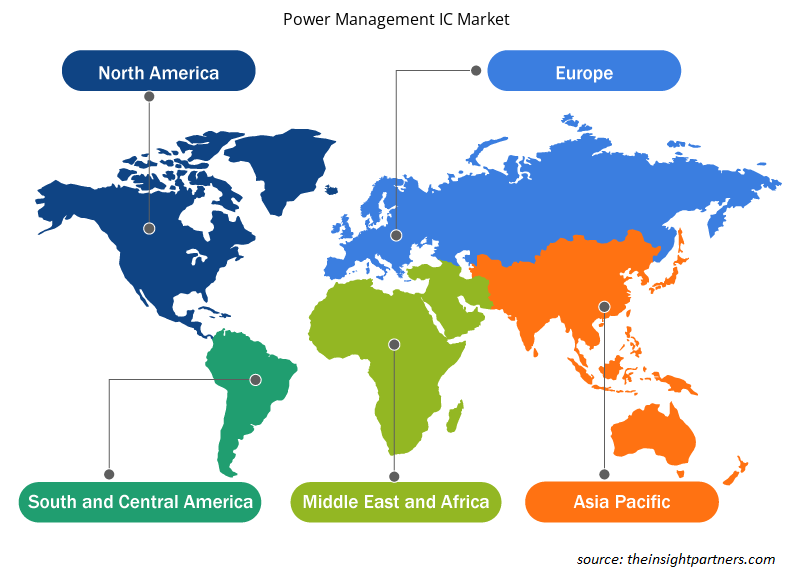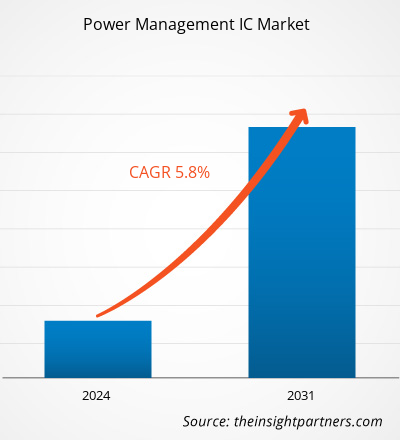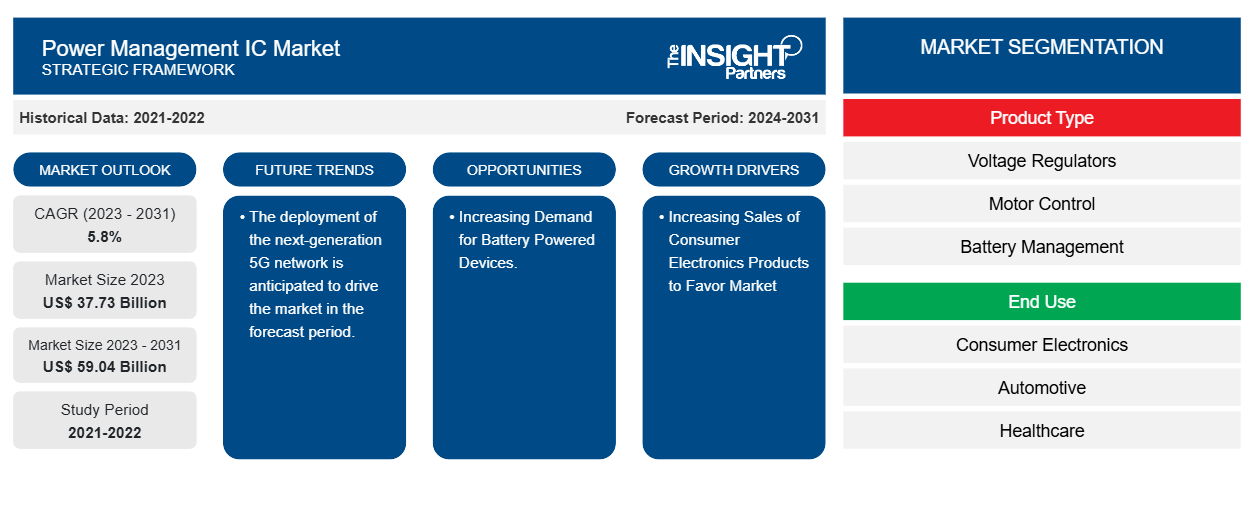Se prevé que el tamaño del mercado de los circuitos integrados de gestión de energía alcance los 59.040 millones de dólares en 2031, frente a los 37.730 millones de dólares en 2023. Se espera que el mercado registre una CAGR del 5,8 % durante el período 2023-2031. Es probable que el aumento de las ventas de productos electrónicos de consumo y la creciente inclinación hacia los vehículos eléctricos sean los principales impulsores y tendencias del mercado.
Análisis del mercado de circuitos integrados de gestión de energía
El mercado de los circuitos integrados de gestión de energía está experimentando un crecimiento significativo a nivel mundial. Este crecimiento se atribuye al aumento de las ventas de productos electrónicos de consumo y a la creciente inclinación hacia los vehículos eléctricos. Además, se prevé que la creciente demanda de dispositivos alimentados por batería y la implementación de redes 5G de próxima generación ofrecerán varias oportunidades para el mercado en los próximos años.
Descripción general del mercado de circuitos integrados de gestión de energía
Los circuitos integrados de administración de energía (PMIC), que integran múltiples reguladores de voltaje y circuitos de control en un solo chip, son excelentes opciones para implementar soluciones completas de suministro de energía. Reducen la cantidad de componentes y el espacio en la placa, al mismo tiempo que administran la energía del sistema de manera fácil y rentable.
Personalice este informe según sus necesidades
Obtendrá personalización en cualquier informe, sin cargo, incluidas partes de este informe o análisis a nivel de país, paquete de datos de Excel, así como también grandes ofertas y descuentos para empresas emergentes y universidades.
- Obtenga las principales tendencias clave del mercado de este informe.Esta muestra GRATUITA incluirá análisis de datos, desde tendencias del mercado hasta estimaciones y pronósticos.
Impulsores y oportunidades del mercado de los circuitos integrados de gestión de energía
Aumentan las ventas de productos electrónicos de consumo para favorecer el mercado
Los productos electrónicos de consumo, como los teléfonos inteligentes, las tabletas, las gafas inteligentes, los cascos de realidad virtual, los relojes inteligentes y las pulseras de actividad física, son cada vez más populares entre los consumidores. Estos dispositivos sirven para diversos fines, como el seguimiento de la actividad y el control de la salud. La demanda de productos electrónicos de consumo impulsa la necesidad de circuitos integrados de gestión de energía. Las áreas de aplicación de los dispositivos portátiles se están expandiendo más allá de la electrónica de consumo para incluir dispositivos médicos y dispositivos de comunicación inalámbrica. En el sector médico, existe un potencial de crecimiento significativo para el mercado de circuitos integrados de gestión de energía en dispositivos médicos portátiles y sistemas de control de la salud inalámbricos a medida que el sector experimenta una transformación tecnológica.
Creciente demanda de dispositivos alimentados por baterías.
Se prevé que la creciente demanda de dispositivos alimentados por batería ofrecerá varias oportunidades para el mercado en los próximos años. Dispositivos como teléfonos móviles, estuches de carga de baterías para teléfonos móviles, computadoras portátiles, cámaras, teléfonos inteligentes, dispositivos electrónicos, registradores de datos, PDA que contienen baterías de litio, juegos, tabletas, relojes, etc. Dispositivos que contienen baterías de litio metálico o de iones de litio (computadoras portátiles, teléfonos inteligentes, tabletas, etc.) Estos dispositivos necesitan maximizar su energía para extender la vida útil de la batería. Los PMIC son esenciales para optimizar la distribución de energía y reducir el desperdicio de energía.
Análisis de segmentación del informe de mercado de IC de gestión de energía
Los segmentos clave que contribuyeron a la derivación del análisis del mercado de circuitos integrados de gestión de energía son el tipo de producto y el uso final.
- Según el tipo de producto, el mercado de circuitos integrados de gestión de energía se divide en reguladores de voltaje, control de motores, gestión de baterías , circuitos integrados multicanal y otros. Se prevé que el segmento de reguladores de voltaje tenga una participación de mercado significativa en el período de pronóstico.
- Según el uso final, el mercado de los circuitos integrados de gestión de energía se divide en electrónica de consumo, automoción, atención sanitaria, TI y telecomunicaciones, industria y otros. Se prevé que el segmento de la electrónica de consumo tenga una cuota de mercado significativa en el período de previsión.
Análisis de la cuota de mercado de los circuitos integrados de gestión de energía por geografía
El alcance geográfico del informe de mercado de IC de gestión de energía se divide principalmente en cinco regiones: América del Norte, Asia Pacífico, Europa, Medio Oriente y África, y América del Sur y Central.
América del Norte ha dominado el mercado de los circuitos integrados de gestión de energía. Las tendencias de adopción de alta tecnología en diversas industrias de la región de América del Norte han impulsado el crecimiento del mercado de los circuitos integrados de gestión de energía. Se espera que factores como la mayor adopción de herramientas digitales, el alto gasto tecnológico por parte de las agencias gubernamentales, el aumento de las ventas de productos electrónicos de consumo y la creciente inclinación hacia los vehículos eléctricos impulsen el crecimiento del mercado de los circuitos integrados de gestión de energía de América del Norte. Además, un fuerte énfasis en la investigación y el desarrollo en las economías desarrolladas de los EE. UU. y Canadá está obligando a los actores norteamericanos a traer soluciones tecnológicamente avanzadas al mercado. Además, los EE. UU. tienen muchos actores del mercado de los circuitos integrados de gestión de energía que se han centrado cada vez más en el desarrollo de soluciones innovadoras. Todos estos factores contribuyen al crecimiento del mercado de los circuitos integrados de gestión de energía de la región.
Perspectivas regionales del mercado de circuitos integrados de gestión de energía
Los analistas de Insight Partners explicaron en detalle las tendencias y los factores regionales que influyen en el mercado de circuitos integrados de gestión de energía durante el período de pronóstico. Esta sección también analiza los segmentos y la geografía del mercado de circuitos integrados de gestión de energía en América del Norte, Europa, Asia Pacífico, Oriente Medio y África, y América del Sur y Central.

- Obtenga datos regionales específicos para el mercado de circuitos integrados de gestión de energía
Alcance del informe de mercado de circuitos integrados de gestión de energía
| Atributo del informe | Detalles |
|---|---|
| Tamaño del mercado en 2023 | US$ 37,73 mil millones |
| Tamaño del mercado en 2031 | US$ 59.04 mil millones |
| CAGR global (2023 - 2031) | 5,8% |
| Datos históricos | 2021-2022 |
| Período de pronóstico | 2024-2031 |
| Segmentos cubiertos | Por tipo de producto
|
| Regiones y países cubiertos | América del norte
|
| Líderes del mercado y perfiles de empresas clave |
|
Densidad de actores del mercado de circuitos integrados de gestión de energía: comprensión de su impacto en la dinámica empresarial
El mercado de circuitos integrados de gestión de energía está creciendo rápidamente, impulsado por la creciente demanda de los usuarios finales debido a factores como la evolución de las preferencias de los consumidores, los avances tecnológicos y una mayor conciencia de los beneficios del producto. A medida que aumenta la demanda, las empresas amplían sus ofertas, innovan para satisfacer las necesidades de los consumidores y aprovechan las tendencias emergentes, lo que impulsa aún más el crecimiento del mercado.
La densidad de actores del mercado se refiere a la distribución de las empresas o firmas que operan dentro de un mercado o industria en particular. Indica cuántos competidores (actores del mercado) están presentes en un espacio de mercado determinado en relación con su tamaño o valor total de mercado.
Las principales empresas que operan en el mercado de circuitos integrados de gestión de energía son:
- Semiconductores NXP
- Dispositivos analógicos Inc.
- Tecnologías Infineon AG
- ROHM CO, LTD.
- Tecnología Microchip Inc.
- Vishay Intertecnología, Inc.
Descargo de responsabilidad : Las empresas enumeradas anteriormente no están clasificadas en ningún orden particular.

- Obtenga una descripción general de los principales actores clave del mercado de IC de gestión de energía
Noticias y desarrollos recientes del mercado de circuitos integrados de gestión de energía
El mercado de los circuitos integrados de gestión de energía se evalúa mediante la recopilación de datos cualitativos y cuantitativos a partir de una investigación primaria y secundaria, que incluye importantes publicaciones corporativas, datos de asociaciones y bases de datos. A continuación, se enumeran algunos de los avances en el mercado de los circuitos integrados de gestión de energía:
- Nordic Semiconductor anunció el lanzamiento de su PMIC (circuito integrado de gestión de energía) nPM1300. Con sus dos convertidores reductores, dos interruptores de carga/convertidores de voltaje de baja caída (LDO) y carga de batería integrada, el nPM1300 es ideal para aplicaciones que funcionan con baterías. (Fuente: sitio web de Nordic Semiconductor Company, junio de 2023)
- Magnachip Semiconductor Corporation anunció que la empresa ha lanzado su primer circuito integrado de gestión de energía (PMIC) para dispositivos informáticos equipados con pantallas OLED. (Fuente: sitio web de la empresa Magnachip Semiconductor Corporation/noviembre de 2023)
Informe sobre el mercado de circuitos integrados de gestión de energía: cobertura y resultados
El informe “Tamaño y pronóstico del mercado de IC de gestión de energía (2021-2031)” proporciona un análisis detallado del mercado que cubre las siguientes áreas:
- Tamaño y pronóstico del mercado de IC de gestión de energía a nivel global, regional y nacional para todos los segmentos clave del mercado cubiertos por el alcance.
- Tendencias del mercado de IC de gestión de energía, así como dinámica del mercado, como impulsores, restricciones y oportunidades clave.
- Análisis detallado PEST/Cinco fuerzas de Porter y FODA.
- Análisis del mercado de IC de gestión de energía que cubre las tendencias clave del mercado, el marco global y regional, los principales actores, las regulaciones y los desarrollos recientes del mercado.
- Análisis del panorama de la industria y la competencia que cubre la concentración del mercado, el análisis del mapa de calor, los actores destacados y los desarrollos recientes en el mercado de circuitos integrados de gestión de energía.
- Perfiles detallados de empresas.
- Análisis histórico (2 años), año base, pronóstico (7 años) con CAGR
- Análisis PEST y FODA
- Tamaño del mercado, valor/volumen: global, regional y nacional
- Industria y panorama competitivo
- Conjunto de datos de Excel
Informes recientes
Informes relacionados
Testimonios
Razón para comprar
- Toma de decisiones informada
- Comprensión de la dinámica del mercado
- Análisis competitivo
- Información sobre clientes
- Pronósticos del mercado
- Mitigación de riesgos
- Planificación estratégica
- Justificación de la inversión
- Identificación de mercados emergentes
- Mejora de las estrategias de marketing
- Impulso de la eficiencia operativa
- Alineación con las tendencias regulatorias





















 Obtenga una muestra gratuita para - Mercado de circuitos integrados de gestión de energía
Obtenga una muestra gratuita para - Mercado de circuitos integrados de gestión de energía